Managing and Coordinating HR Functions: Tesco and Marriott Report
VerifiedAdded on 2023/01/05
|14
|4087
|68
Report
AI Summary
This report provides a comprehensive analysis of Human Resource Management (HRM) functions, focusing on two major players: Tesco, a British multinational retailer, and Marriott, a leading hospitality company in the Asia-Pacific region. The report delves into key HRM areas such as planning, recruitment and selection, talent management, diversity management, and employee engagement. It explores the evolution of HR functions from business function to strategic partner, highlighting the importance of talent management strategies in attracting and retaining high-quality employees. The report examines the specific HRM practices of Tesco and Marriott, discussing their approaches to recruitment, selection, and diversity. Furthermore, it identifies and analyzes various issues faced by both companies, including challenges in recruitment, talent management, and employee engagement, offering a critical evaluation of their HRM effectiveness in different organizational contexts. The report concludes with a discussion of the challenges and successes of HRM in these two distinct organizational types.
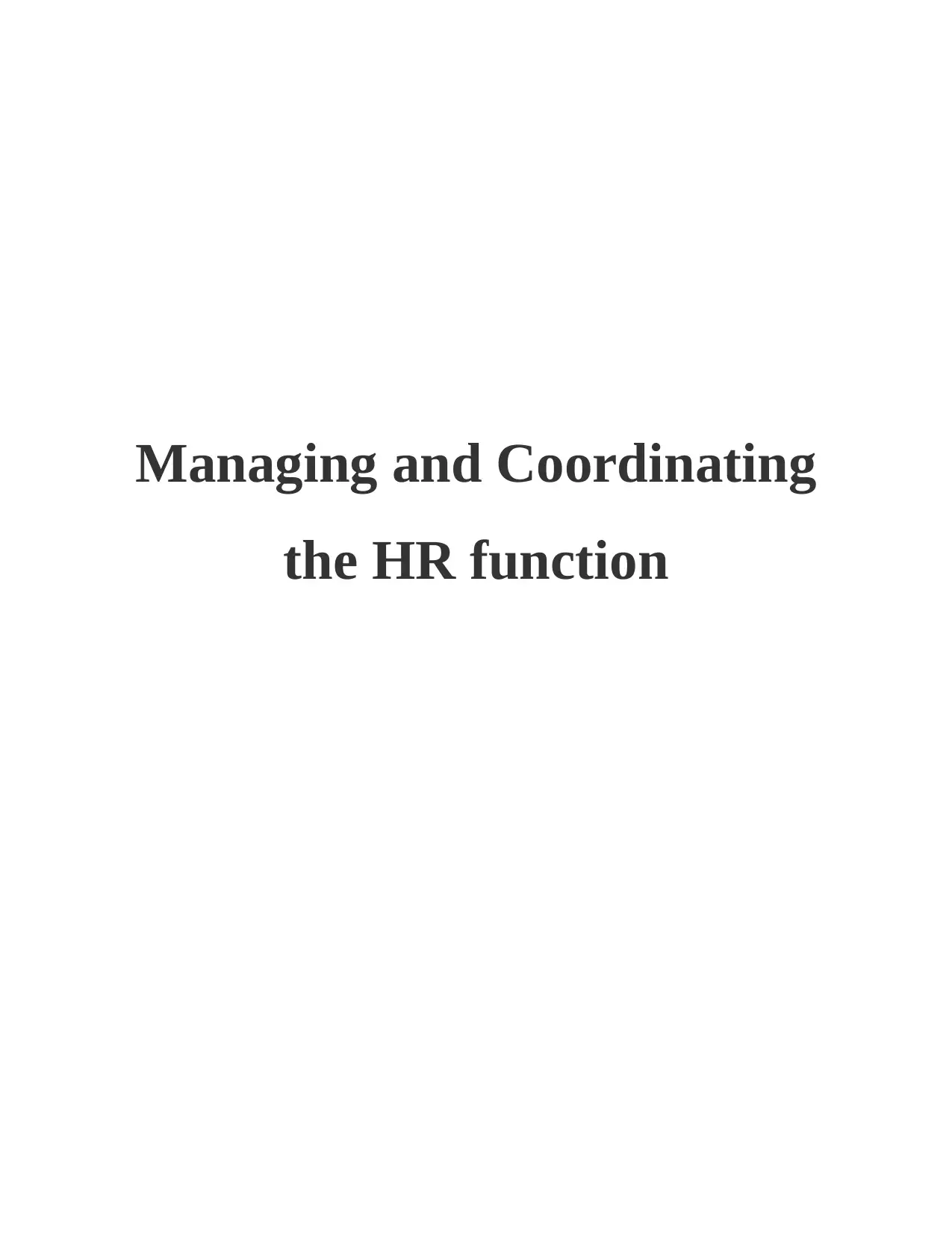
Managing and Coordinating
the HR function
the HR function
Paraphrase This Document
Need a fresh take? Get an instant paraphrase of this document with our AI Paraphraser

Executive Summary
Two major players in two different organisational types in two different countries were
highlighted in the report and their effectiveness of their HRM functions were discussed. The
report elaborated the major functions of the HRM like Planning, Recruitment and Selection,
Diversity management, Talent management, Performance management and many more.
Furthermore, various issues which both the companies face which mainly represented the two
completely different industries were also mentioned. The overall report was a kind of critical
evaluation of the Hr functions in two different organisational types and countries.
Two major players in two different organisational types in two different countries were
highlighted in the report and their effectiveness of their HRM functions were discussed. The
report elaborated the major functions of the HRM like Planning, Recruitment and Selection,
Diversity management, Talent management, Performance management and many more.
Furthermore, various issues which both the companies face which mainly represented the two
completely different industries were also mentioned. The overall report was a kind of critical
evaluation of the Hr functions in two different organisational types and countries.
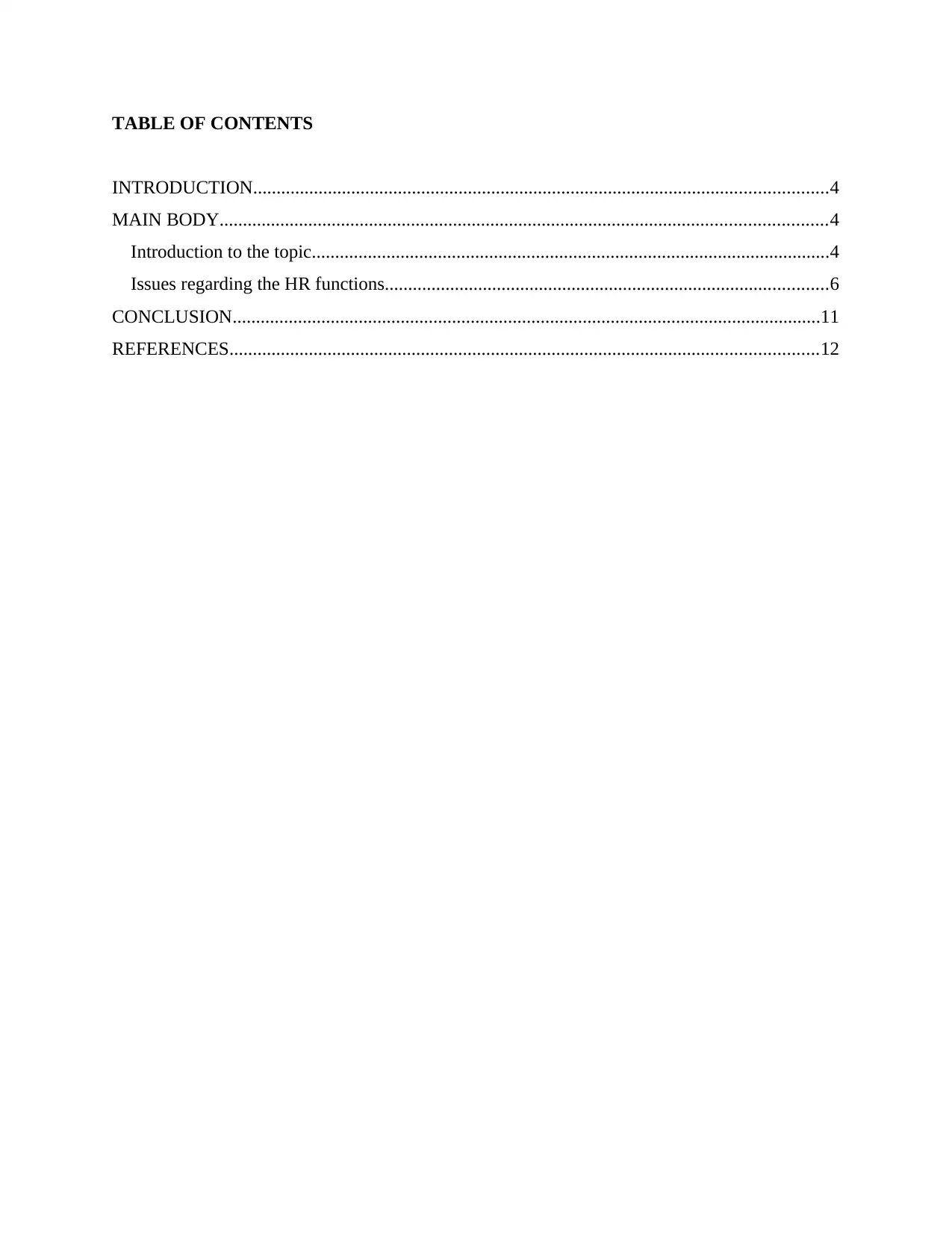
TABLE OF CONTENTS
INTRODUCTION...........................................................................................................................4
MAIN BODY..................................................................................................................................4
Introduction to the topic...............................................................................................................4
Issues regarding the HR functions...............................................................................................6
CONCLUSION..............................................................................................................................11
REFERENCES..............................................................................................................................12
INTRODUCTION...........................................................................................................................4
MAIN BODY..................................................................................................................................4
Introduction to the topic...............................................................................................................4
Issues regarding the HR functions...............................................................................................6
CONCLUSION..............................................................................................................................11
REFERENCES..............................................................................................................................12
⊘ This is a preview!⊘
Do you want full access?
Subscribe today to unlock all pages.

Trusted by 1+ million students worldwide
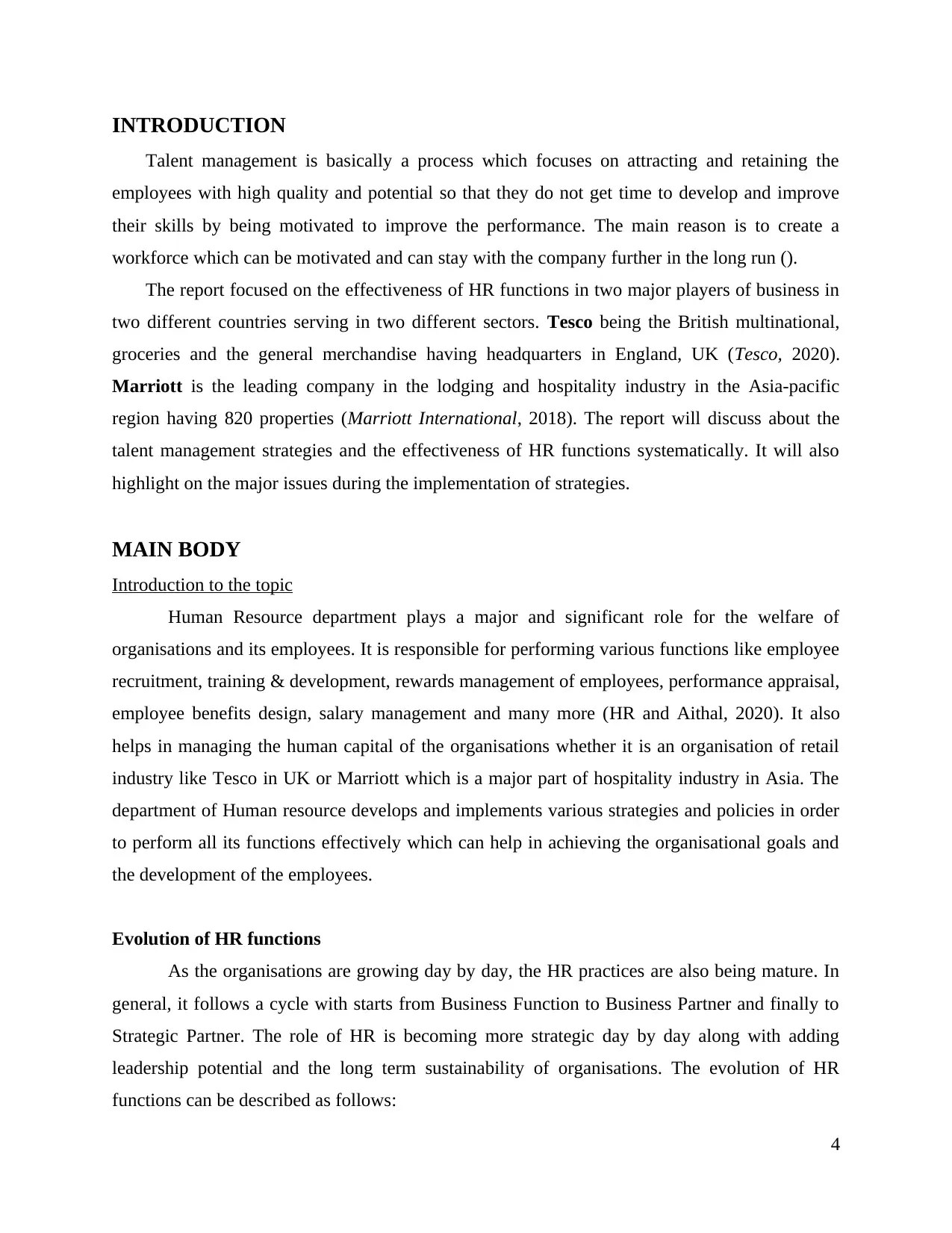
INTRODUCTION
Talent management is basically a process which focuses on attracting and retaining the
employees with high quality and potential so that they do not get time to develop and improve
their skills by being motivated to improve the performance. The main reason is to create a
workforce which can be motivated and can stay with the company further in the long run ().
The report focused on the effectiveness of HR functions in two major players of business in
two different countries serving in two different sectors. Tesco being the British multinational,
groceries and the general merchandise having headquarters in England, UK (Tesco, 2020).
Marriott is the leading company in the lodging and hospitality industry in the Asia-pacific
region having 820 properties (Marriott International, 2018). The report will discuss about the
talent management strategies and the effectiveness of HR functions systematically. It will also
highlight on the major issues during the implementation of strategies.
MAIN BODY
Introduction to the topic
Human Resource department plays a major and significant role for the welfare of
organisations and its employees. It is responsible for performing various functions like employee
recruitment, training & development, rewards management of employees, performance appraisal,
employee benefits design, salary management and many more (HR and Aithal, 2020). It also
helps in managing the human capital of the organisations whether it is an organisation of retail
industry like Tesco in UK or Marriott which is a major part of hospitality industry in Asia. The
department of Human resource develops and implements various strategies and policies in order
to perform all its functions effectively which can help in achieving the organisational goals and
the development of the employees.
Evolution of HR functions
As the organisations are growing day by day, the HR practices are also being mature. In
general, it follows a cycle with starts from Business Function to Business Partner and finally to
Strategic Partner. The role of HR is becoming more strategic day by day along with adding
leadership potential and the long term sustainability of organisations. The evolution of HR
functions can be described as follows:
4
Talent management is basically a process which focuses on attracting and retaining the
employees with high quality and potential so that they do not get time to develop and improve
their skills by being motivated to improve the performance. The main reason is to create a
workforce which can be motivated and can stay with the company further in the long run ().
The report focused on the effectiveness of HR functions in two major players of business in
two different countries serving in two different sectors. Tesco being the British multinational,
groceries and the general merchandise having headquarters in England, UK (Tesco, 2020).
Marriott is the leading company in the lodging and hospitality industry in the Asia-pacific
region having 820 properties (Marriott International, 2018). The report will discuss about the
talent management strategies and the effectiveness of HR functions systematically. It will also
highlight on the major issues during the implementation of strategies.
MAIN BODY
Introduction to the topic
Human Resource department plays a major and significant role for the welfare of
organisations and its employees. It is responsible for performing various functions like employee
recruitment, training & development, rewards management of employees, performance appraisal,
employee benefits design, salary management and many more (HR and Aithal, 2020). It also
helps in managing the human capital of the organisations whether it is an organisation of retail
industry like Tesco in UK or Marriott which is a major part of hospitality industry in Asia. The
department of Human resource develops and implements various strategies and policies in order
to perform all its functions effectively which can help in achieving the organisational goals and
the development of the employees.
Evolution of HR functions
As the organisations are growing day by day, the HR practices are also being mature. In
general, it follows a cycle with starts from Business Function to Business Partner and finally to
Strategic Partner. The role of HR is becoming more strategic day by day along with adding
leadership potential and the long term sustainability of organisations. The evolution of HR
functions can be described as follows:
4
Paraphrase This Document
Need a fresh take? Get an instant paraphrase of this document with our AI Paraphraser
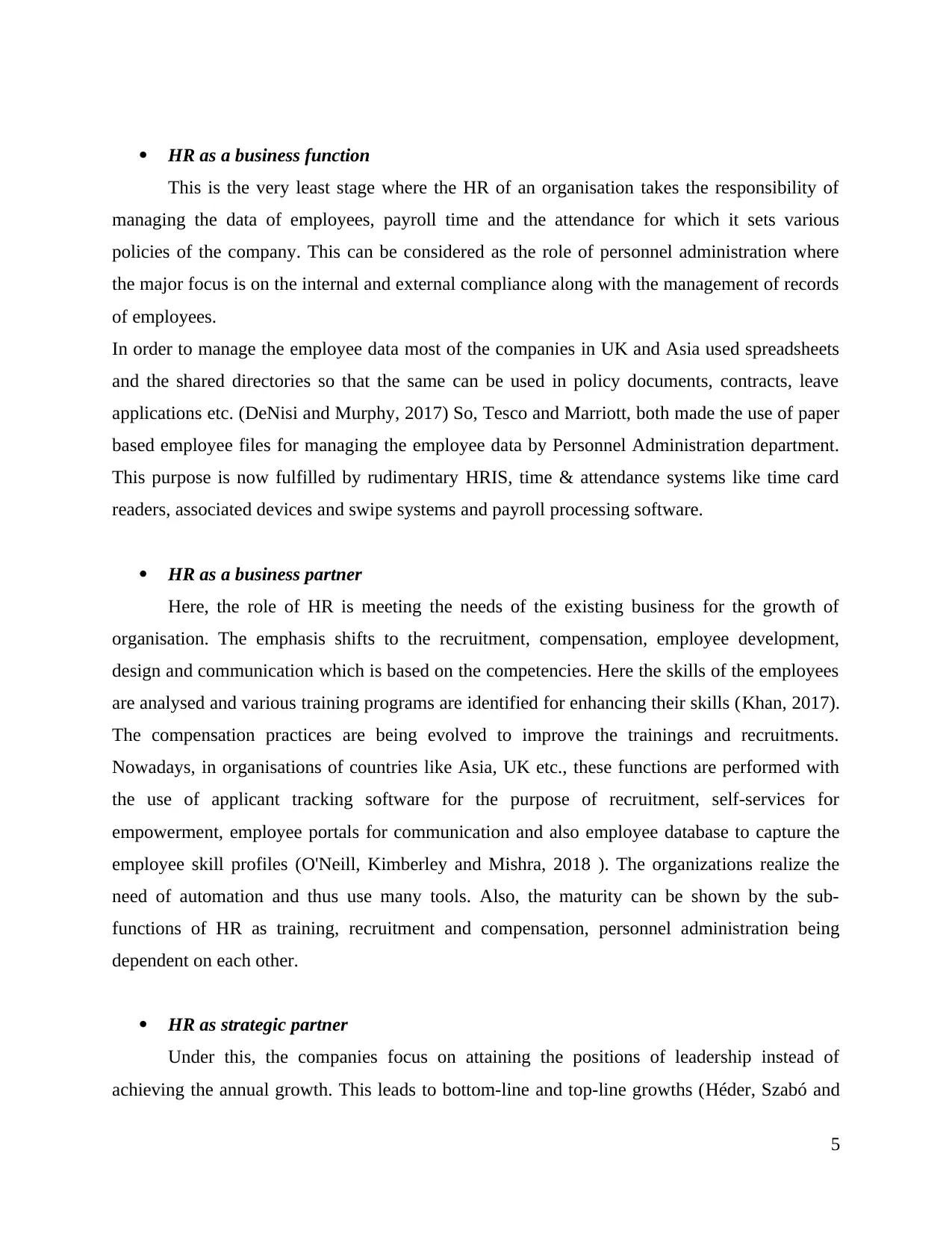
HR as a business function
This is the very least stage where the HR of an organisation takes the responsibility of
managing the data of employees, payroll time and the attendance for which it sets various
policies of the company. This can be considered as the role of personnel administration where
the major focus is on the internal and external compliance along with the management of records
of employees.
In order to manage the employee data most of the companies in UK and Asia used spreadsheets
and the shared directories so that the same can be used in policy documents, contracts, leave
applications etc. (DeNisi and Murphy, 2017) So, Tesco and Marriott, both made the use of paper
based employee files for managing the employee data by Personnel Administration department.
This purpose is now fulfilled by rudimentary HRIS, time & attendance systems like time card
readers, associated devices and swipe systems and payroll processing software.
HR as a business partner
Here, the role of HR is meeting the needs of the existing business for the growth of
organisation. The emphasis shifts to the recruitment, compensation, employee development,
design and communication which is based on the competencies. Here the skills of the employees
are analysed and various training programs are identified for enhancing their skills (Khan, 2017).
The compensation practices are being evolved to improve the trainings and recruitments.
Nowadays, in organisations of countries like Asia, UK etc., these functions are performed with
the use of applicant tracking software for the purpose of recruitment, self-services for
empowerment, employee portals for communication and also employee database to capture the
employee skill profiles (O'Neill, Kimberley and Mishra, 2018 ). The organizations realize the
need of automation and thus use many tools. Also, the maturity can be shown by the sub-
functions of HR as training, recruitment and compensation, personnel administration being
dependent on each other.
HR as strategic partner
Under this, the companies focus on attaining the positions of leadership instead of
achieving the annual growth. This leads to bottom-line and top-line growths (Héder, Szabó and
5
This is the very least stage where the HR of an organisation takes the responsibility of
managing the data of employees, payroll time and the attendance for which it sets various
policies of the company. This can be considered as the role of personnel administration where
the major focus is on the internal and external compliance along with the management of records
of employees.
In order to manage the employee data most of the companies in UK and Asia used spreadsheets
and the shared directories so that the same can be used in policy documents, contracts, leave
applications etc. (DeNisi and Murphy, 2017) So, Tesco and Marriott, both made the use of paper
based employee files for managing the employee data by Personnel Administration department.
This purpose is now fulfilled by rudimentary HRIS, time & attendance systems like time card
readers, associated devices and swipe systems and payroll processing software.
HR as a business partner
Here, the role of HR is meeting the needs of the existing business for the growth of
organisation. The emphasis shifts to the recruitment, compensation, employee development,
design and communication which is based on the competencies. Here the skills of the employees
are analysed and various training programs are identified for enhancing their skills (Khan, 2017).
The compensation practices are being evolved to improve the trainings and recruitments.
Nowadays, in organisations of countries like Asia, UK etc., these functions are performed with
the use of applicant tracking software for the purpose of recruitment, self-services for
empowerment, employee portals for communication and also employee database to capture the
employee skill profiles (O'Neill, Kimberley and Mishra, 2018 ). The organizations realize the
need of automation and thus use many tools. Also, the maturity can be shown by the sub-
functions of HR as training, recruitment and compensation, personnel administration being
dependent on each other.
HR as strategic partner
Under this, the companies focus on attaining the positions of leadership instead of
achieving the annual growth. This leads to bottom-line and top-line growths (Héder, Szabó and
5
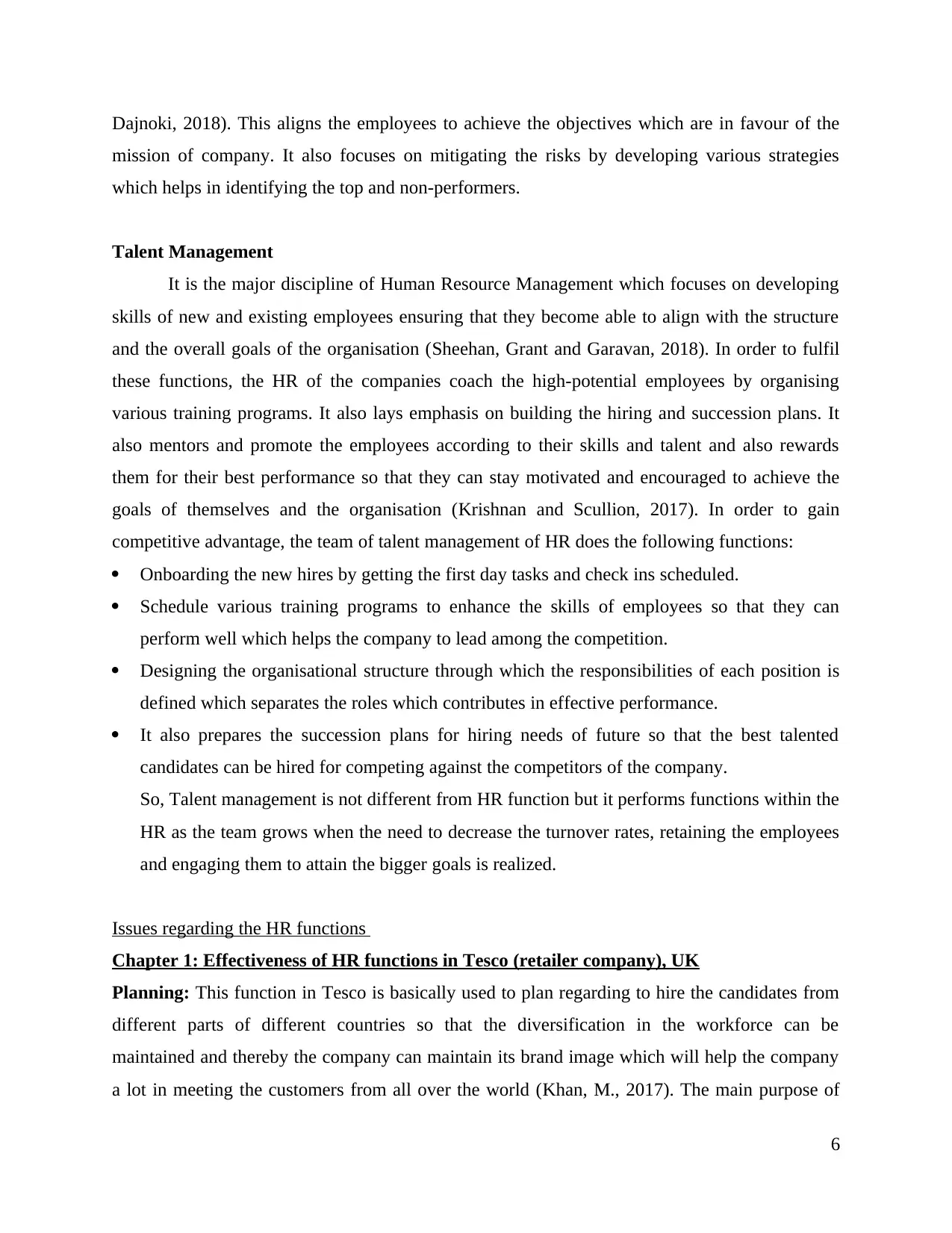
Dajnoki, 2018). This aligns the employees to achieve the objectives which are in favour of the
mission of company. It also focuses on mitigating the risks by developing various strategies
which helps in identifying the top and non-performers.
Talent Management
It is the major discipline of Human Resource Management which focuses on developing
skills of new and existing employees ensuring that they become able to align with the structure
and the overall goals of the organisation (Sheehan, Grant and Garavan, 2018). In order to fulfil
these functions, the HR of the companies coach the high-potential employees by organising
various training programs. It also lays emphasis on building the hiring and succession plans. It
also mentors and promote the employees according to their skills and talent and also rewards
them for their best performance so that they can stay motivated and encouraged to achieve the
goals of themselves and the organisation (Krishnan and Scullion, 2017). In order to gain
competitive advantage, the team of talent management of HR does the following functions:
Onboarding the new hires by getting the first day tasks and check ins scheduled.
Schedule various training programs to enhance the skills of employees so that they can
perform well which helps the company to lead among the competition.
Designing the organisational structure through which the responsibilities of each position is
defined which separates the roles which contributes in effective performance.
It also prepares the succession plans for hiring needs of future so that the best talented
candidates can be hired for competing against the competitors of the company.
So, Talent management is not different from HR function but it performs functions within the
HR as the team grows when the need to decrease the turnover rates, retaining the employees
and engaging them to attain the bigger goals is realized.
Issues regarding the HR functions
Chapter 1: Effectiveness of HR functions in Tesco (retailer company), UK
Planning: This function in Tesco is basically used to plan regarding to hire the candidates from
different parts of different countries so that the diversification in the workforce can be
maintained and thereby the company can maintain its brand image which will help the company
a lot in meeting the customers from all over the world (Khan, M., 2017). The main purpose of
6
mission of company. It also focuses on mitigating the risks by developing various strategies
which helps in identifying the top and non-performers.
Talent Management
It is the major discipline of Human Resource Management which focuses on developing
skills of new and existing employees ensuring that they become able to align with the structure
and the overall goals of the organisation (Sheehan, Grant and Garavan, 2018). In order to fulfil
these functions, the HR of the companies coach the high-potential employees by organising
various training programs. It also lays emphasis on building the hiring and succession plans. It
also mentors and promote the employees according to their skills and talent and also rewards
them for their best performance so that they can stay motivated and encouraged to achieve the
goals of themselves and the organisation (Krishnan and Scullion, 2017). In order to gain
competitive advantage, the team of talent management of HR does the following functions:
Onboarding the new hires by getting the first day tasks and check ins scheduled.
Schedule various training programs to enhance the skills of employees so that they can
perform well which helps the company to lead among the competition.
Designing the organisational structure through which the responsibilities of each position is
defined which separates the roles which contributes in effective performance.
It also prepares the succession plans for hiring needs of future so that the best talented
candidates can be hired for competing against the competitors of the company.
So, Talent management is not different from HR function but it performs functions within the
HR as the team grows when the need to decrease the turnover rates, retaining the employees
and engaging them to attain the bigger goals is realized.
Issues regarding the HR functions
Chapter 1: Effectiveness of HR functions in Tesco (retailer company), UK
Planning: This function in Tesco is basically used to plan regarding to hire the candidates from
different parts of different countries so that the diversification in the workforce can be
maintained and thereby the company can maintain its brand image which will help the company
a lot in meeting the customers from all over the world (Khan, M., 2017). The main purpose of
6
⊘ This is a preview!⊘
Do you want full access?
Subscribe today to unlock all pages.

Trusted by 1+ million students worldwide
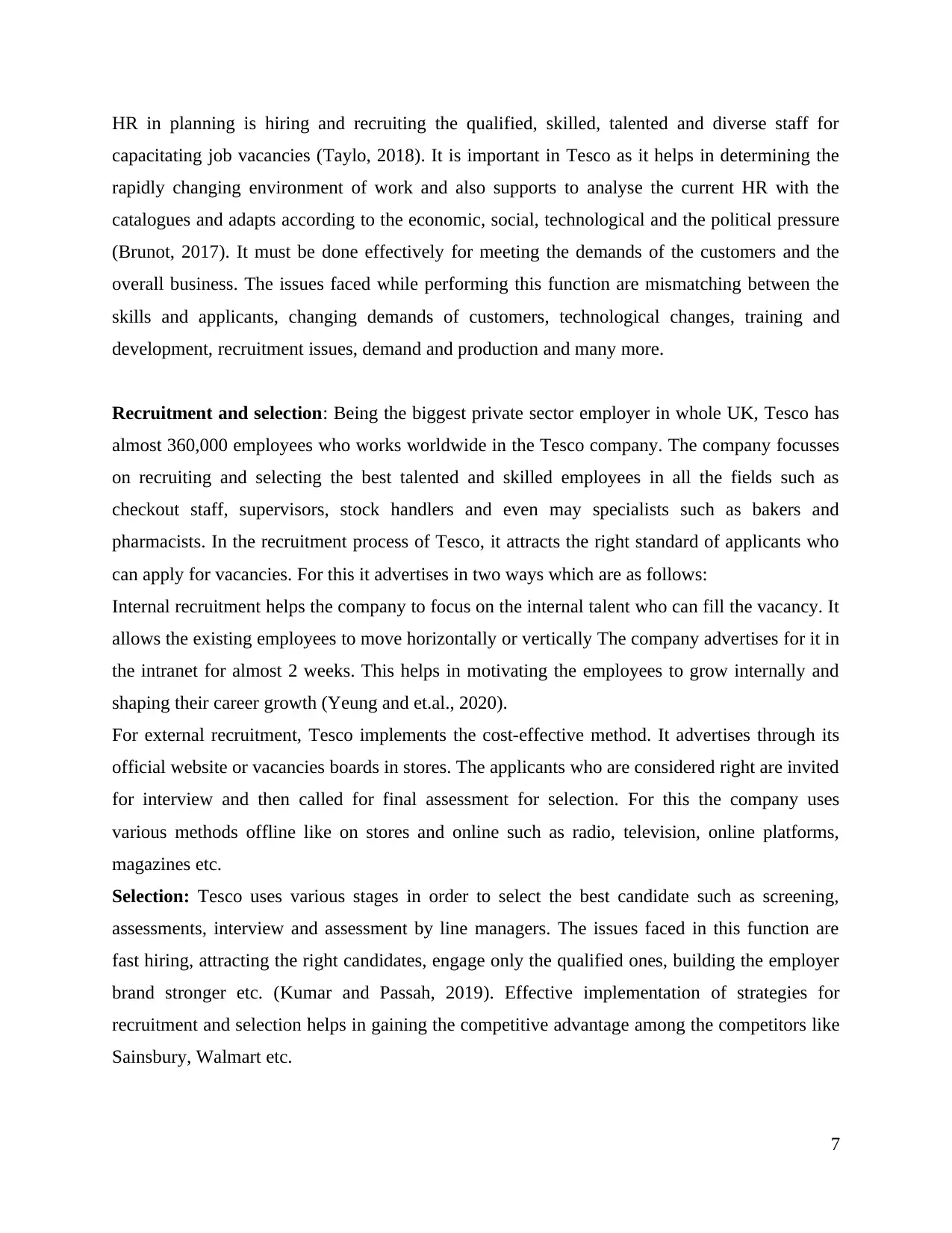
HR in planning is hiring and recruiting the qualified, skilled, talented and diverse staff for
capacitating job vacancies (Taylo, 2018). It is important in Tesco as it helps in determining the
rapidly changing environment of work and also supports to analyse the current HR with the
catalogues and adapts according to the economic, social, technological and the political pressure
(Brunot, 2017). It must be done effectively for meeting the demands of the customers and the
overall business. The issues faced while performing this function are mismatching between the
skills and applicants, changing demands of customers, technological changes, training and
development, recruitment issues, demand and production and many more.
Recruitment and selection: Being the biggest private sector employer in whole UK, Tesco has
almost 360,000 employees who works worldwide in the Tesco company. The company focusses
on recruiting and selecting the best talented and skilled employees in all the fields such as
checkout staff, supervisors, stock handlers and even may specialists such as bakers and
pharmacists. In the recruitment process of Tesco, it attracts the right standard of applicants who
can apply for vacancies. For this it advertises in two ways which are as follows:
Internal recruitment helps the company to focus on the internal talent who can fill the vacancy. It
allows the existing employees to move horizontally or vertically The company advertises for it in
the intranet for almost 2 weeks. This helps in motivating the employees to grow internally and
shaping their career growth (Yeung and et.al., 2020).
For external recruitment, Tesco implements the cost-effective method. It advertises through its
official website or vacancies boards in stores. The applicants who are considered right are invited
for interview and then called for final assessment for selection. For this the company uses
various methods offline like on stores and online such as radio, television, online platforms,
magazines etc.
Selection: Tesco uses various stages in order to select the best candidate such as screening,
assessments, interview and assessment by line managers. The issues faced in this function are
fast hiring, attracting the right candidates, engage only the qualified ones, building the employer
brand stronger etc. (Kumar and Passah, 2019). Effective implementation of strategies for
recruitment and selection helps in gaining the competitive advantage among the competitors like
Sainsbury, Walmart etc.
7
capacitating job vacancies (Taylo, 2018). It is important in Tesco as it helps in determining the
rapidly changing environment of work and also supports to analyse the current HR with the
catalogues and adapts according to the economic, social, technological and the political pressure
(Brunot, 2017). It must be done effectively for meeting the demands of the customers and the
overall business. The issues faced while performing this function are mismatching between the
skills and applicants, changing demands of customers, technological changes, training and
development, recruitment issues, demand and production and many more.
Recruitment and selection: Being the biggest private sector employer in whole UK, Tesco has
almost 360,000 employees who works worldwide in the Tesco company. The company focusses
on recruiting and selecting the best talented and skilled employees in all the fields such as
checkout staff, supervisors, stock handlers and even may specialists such as bakers and
pharmacists. In the recruitment process of Tesco, it attracts the right standard of applicants who
can apply for vacancies. For this it advertises in two ways which are as follows:
Internal recruitment helps the company to focus on the internal talent who can fill the vacancy. It
allows the existing employees to move horizontally or vertically The company advertises for it in
the intranet for almost 2 weeks. This helps in motivating the employees to grow internally and
shaping their career growth (Yeung and et.al., 2020).
For external recruitment, Tesco implements the cost-effective method. It advertises through its
official website or vacancies boards in stores. The applicants who are considered right are invited
for interview and then called for final assessment for selection. For this the company uses
various methods offline like on stores and online such as radio, television, online platforms,
magazines etc.
Selection: Tesco uses various stages in order to select the best candidate such as screening,
assessments, interview and assessment by line managers. The issues faced in this function are
fast hiring, attracting the right candidates, engage only the qualified ones, building the employer
brand stronger etc. (Kumar and Passah, 2019). Effective implementation of strategies for
recruitment and selection helps in gaining the competitive advantage among the competitors like
Sainsbury, Walmart etc.
7
Paraphrase This Document
Need a fresh take? Get an instant paraphrase of this document with our AI Paraphraser
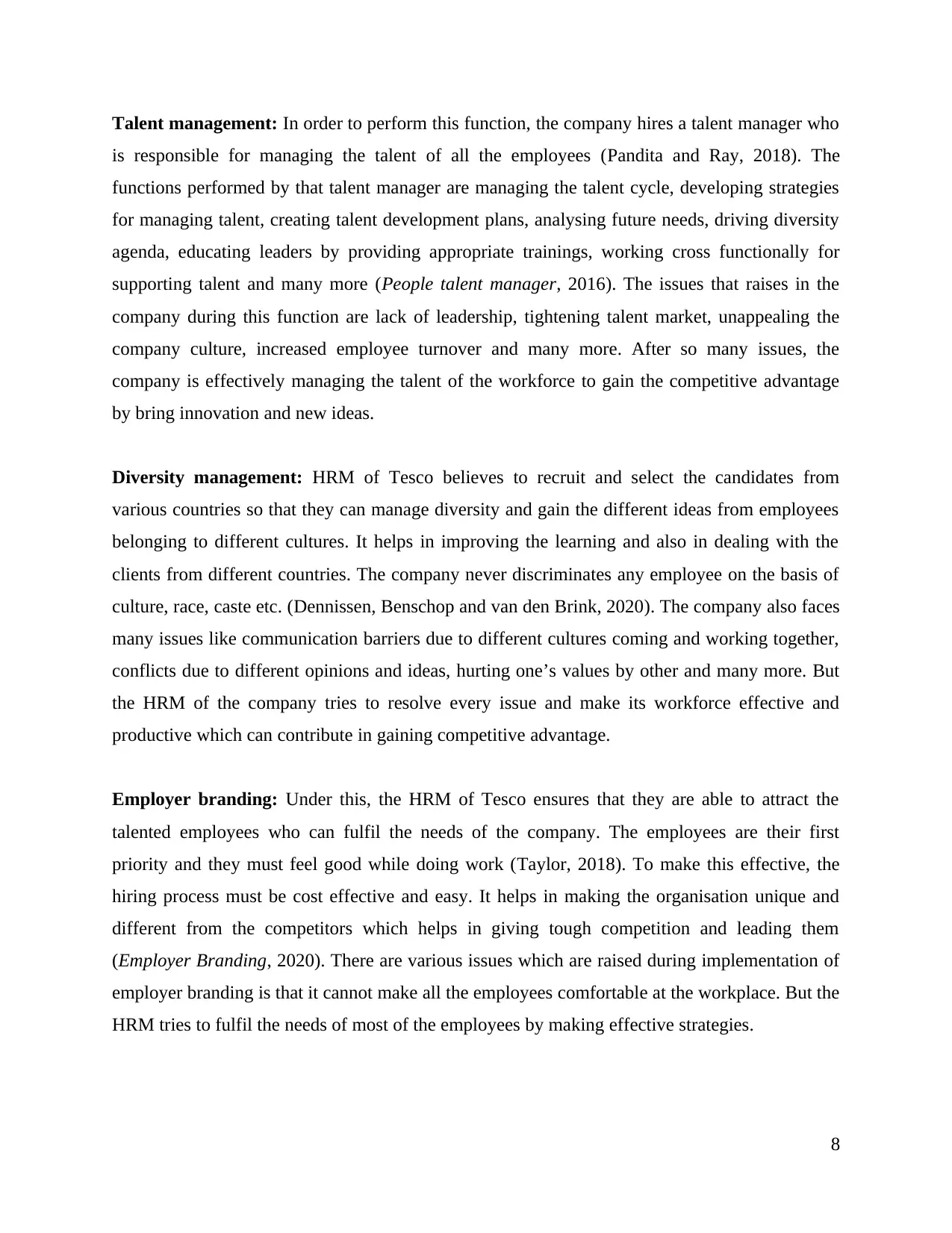
Talent management: In order to perform this function, the company hires a talent manager who
is responsible for managing the talent of all the employees (Pandita and Ray, 2018). The
functions performed by that talent manager are managing the talent cycle, developing strategies
for managing talent, creating talent development plans, analysing future needs, driving diversity
agenda, educating leaders by providing appropriate trainings, working cross functionally for
supporting talent and many more (People talent manager, 2016). The issues that raises in the
company during this function are lack of leadership, tightening talent market, unappealing the
company culture, increased employee turnover and many more. After so many issues, the
company is effectively managing the talent of the workforce to gain the competitive advantage
by bring innovation and new ideas.
Diversity management: HRM of Tesco believes to recruit and select the candidates from
various countries so that they can manage diversity and gain the different ideas from employees
belonging to different cultures. It helps in improving the learning and also in dealing with the
clients from different countries. The company never discriminates any employee on the basis of
culture, race, caste etc. (Dennissen, Benschop and van den Brink, 2020). The company also faces
many issues like communication barriers due to different cultures coming and working together,
conflicts due to different opinions and ideas, hurting one’s values by other and many more. But
the HRM of the company tries to resolve every issue and make its workforce effective and
productive which can contribute in gaining competitive advantage.
Employer branding: Under this, the HRM of Tesco ensures that they are able to attract the
talented employees who can fulfil the needs of the company. The employees are their first
priority and they must feel good while doing work (Taylor, 2018). To make this effective, the
hiring process must be cost effective and easy. It helps in making the organisation unique and
different from the competitors which helps in giving tough competition and leading them
(Employer Branding, 2020). There are various issues which are raised during implementation of
employer branding is that it cannot make all the employees comfortable at the workplace. But the
HRM tries to fulfil the needs of most of the employees by making effective strategies.
8
is responsible for managing the talent of all the employees (Pandita and Ray, 2018). The
functions performed by that talent manager are managing the talent cycle, developing strategies
for managing talent, creating talent development plans, analysing future needs, driving diversity
agenda, educating leaders by providing appropriate trainings, working cross functionally for
supporting talent and many more (People talent manager, 2016). The issues that raises in the
company during this function are lack of leadership, tightening talent market, unappealing the
company culture, increased employee turnover and many more. After so many issues, the
company is effectively managing the talent of the workforce to gain the competitive advantage
by bring innovation and new ideas.
Diversity management: HRM of Tesco believes to recruit and select the candidates from
various countries so that they can manage diversity and gain the different ideas from employees
belonging to different cultures. It helps in improving the learning and also in dealing with the
clients from different countries. The company never discriminates any employee on the basis of
culture, race, caste etc. (Dennissen, Benschop and van den Brink, 2020). The company also faces
many issues like communication barriers due to different cultures coming and working together,
conflicts due to different opinions and ideas, hurting one’s values by other and many more. But
the HRM of the company tries to resolve every issue and make its workforce effective and
productive which can contribute in gaining competitive advantage.
Employer branding: Under this, the HRM of Tesco ensures that they are able to attract the
talented employees who can fulfil the needs of the company. The employees are their first
priority and they must feel good while doing work (Taylor, 2018). To make this effective, the
hiring process must be cost effective and easy. It helps in making the organisation unique and
different from the competitors which helps in giving tough competition and leading them
(Employer Branding, 2020). There are various issues which are raised during implementation of
employer branding is that it cannot make all the employees comfortable at the workplace. But the
HRM tries to fulfil the needs of most of the employees by making effective strategies.
8
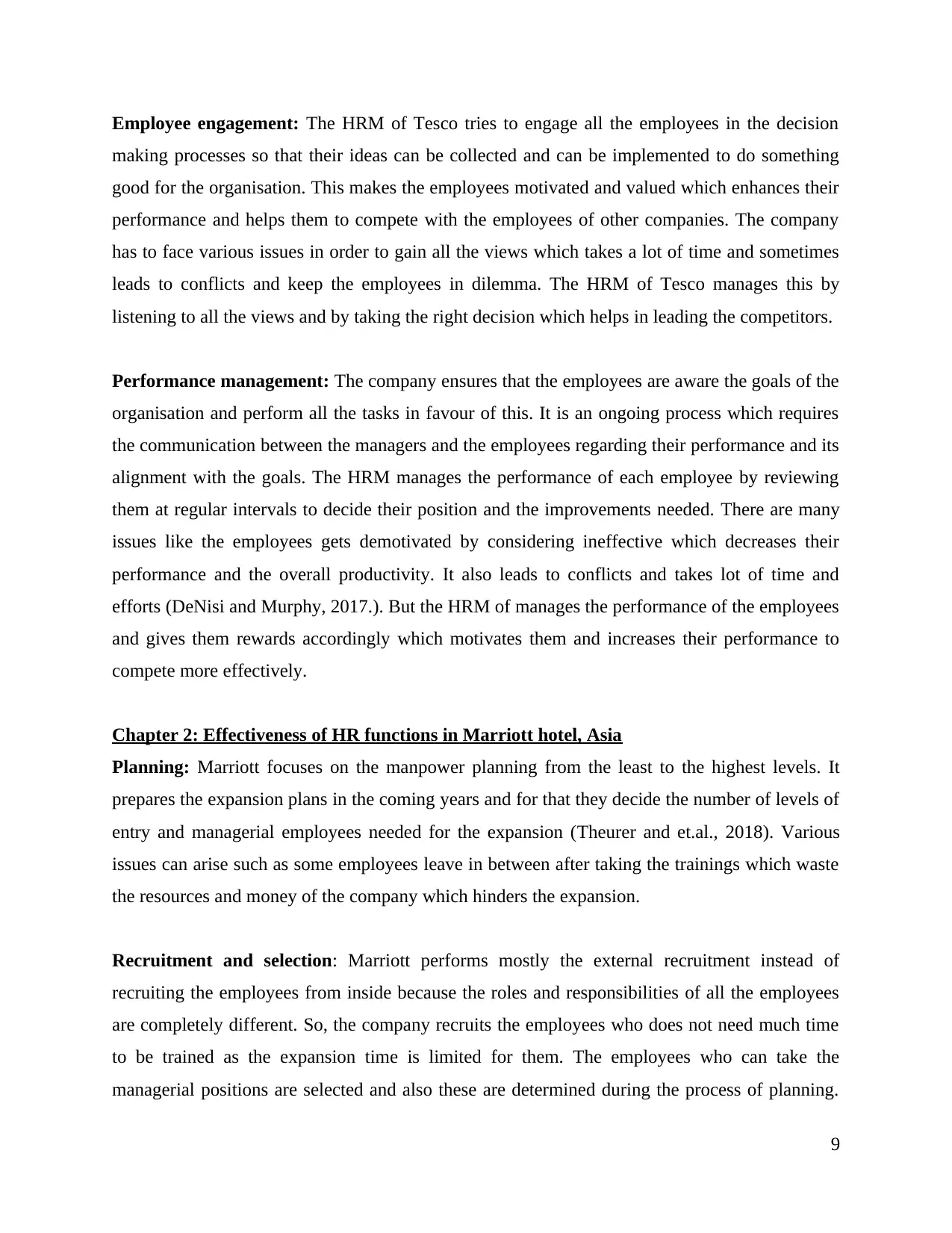
Employee engagement: The HRM of Tesco tries to engage all the employees in the decision
making processes so that their ideas can be collected and can be implemented to do something
good for the organisation. This makes the employees motivated and valued which enhances their
performance and helps them to compete with the employees of other companies. The company
has to face various issues in order to gain all the views which takes a lot of time and sometimes
leads to conflicts and keep the employees in dilemma. The HRM of Tesco manages this by
listening to all the views and by taking the right decision which helps in leading the competitors.
Performance management: The company ensures that the employees are aware the goals of the
organisation and perform all the tasks in favour of this. It is an ongoing process which requires
the communication between the managers and the employees regarding their performance and its
alignment with the goals. The HRM manages the performance of each employee by reviewing
them at regular intervals to decide their position and the improvements needed. There are many
issues like the employees gets demotivated by considering ineffective which decreases their
performance and the overall productivity. It also leads to conflicts and takes lot of time and
efforts (DeNisi and Murphy, 2017.). But the HRM of manages the performance of the employees
and gives them rewards accordingly which motivates them and increases their performance to
compete more effectively.
Chapter 2: Effectiveness of HR functions in Marriott hotel, Asia
Planning: Marriott focuses on the manpower planning from the least to the highest levels. It
prepares the expansion plans in the coming years and for that they decide the number of levels of
entry and managerial employees needed for the expansion (Theurer and et.al., 2018). Various
issues can arise such as some employees leave in between after taking the trainings which waste
the resources and money of the company which hinders the expansion.
Recruitment and selection: Marriott performs mostly the external recruitment instead of
recruiting the employees from inside because the roles and responsibilities of all the employees
are completely different. So, the company recruits the employees who does not need much time
to be trained as the expansion time is limited for them. The employees who can take the
managerial positions are selected and also these are determined during the process of planning.
9
making processes so that their ideas can be collected and can be implemented to do something
good for the organisation. This makes the employees motivated and valued which enhances their
performance and helps them to compete with the employees of other companies. The company
has to face various issues in order to gain all the views which takes a lot of time and sometimes
leads to conflicts and keep the employees in dilemma. The HRM of Tesco manages this by
listening to all the views and by taking the right decision which helps in leading the competitors.
Performance management: The company ensures that the employees are aware the goals of the
organisation and perform all the tasks in favour of this. It is an ongoing process which requires
the communication between the managers and the employees regarding their performance and its
alignment with the goals. The HRM manages the performance of each employee by reviewing
them at regular intervals to decide their position and the improvements needed. There are many
issues like the employees gets demotivated by considering ineffective which decreases their
performance and the overall productivity. It also leads to conflicts and takes lot of time and
efforts (DeNisi and Murphy, 2017.). But the HRM of manages the performance of the employees
and gives them rewards accordingly which motivates them and increases their performance to
compete more effectively.
Chapter 2: Effectiveness of HR functions in Marriott hotel, Asia
Planning: Marriott focuses on the manpower planning from the least to the highest levels. It
prepares the expansion plans in the coming years and for that they decide the number of levels of
entry and managerial employees needed for the expansion (Theurer and et.al., 2018). Various
issues can arise such as some employees leave in between after taking the trainings which waste
the resources and money of the company which hinders the expansion.
Recruitment and selection: Marriott performs mostly the external recruitment instead of
recruiting the employees from inside because the roles and responsibilities of all the employees
are completely different. So, the company recruits the employees who does not need much time
to be trained as the expansion time is limited for them. The employees who can take the
managerial positions are selected and also these are determined during the process of planning.
9
⊘ This is a preview!⊘
Do you want full access?
Subscribe today to unlock all pages.

Trusted by 1+ million students worldwide
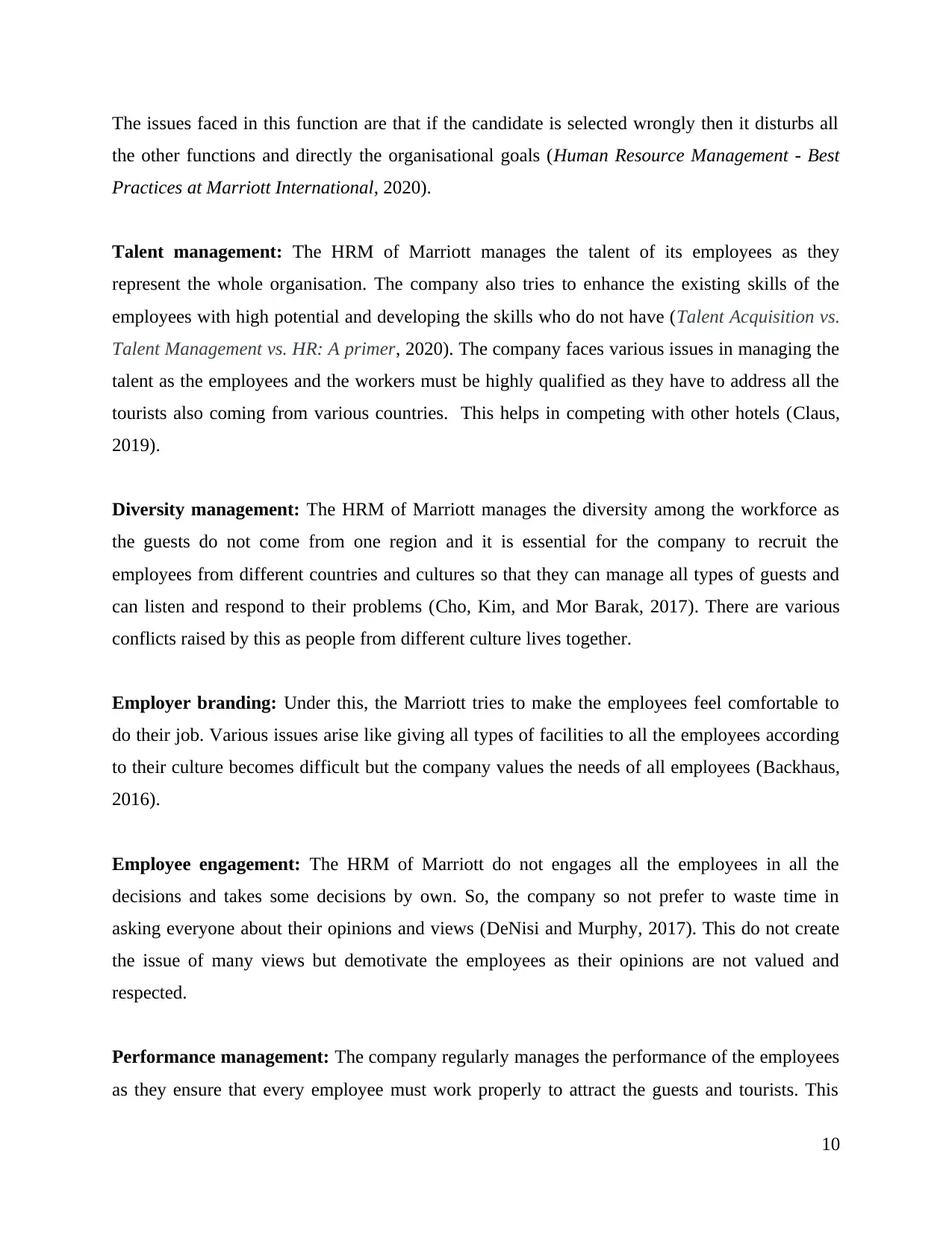
The issues faced in this function are that if the candidate is selected wrongly then it disturbs all
the other functions and directly the organisational goals (Human Resource Management - Best
Practices at Marriott International, 2020).
Talent management: The HRM of Marriott manages the talent of its employees as they
represent the whole organisation. The company also tries to enhance the existing skills of the
employees with high potential and developing the skills who do not have (Talent Acquisition vs.
Talent Management vs. HR: A primer, 2020). The company faces various issues in managing the
talent as the employees and the workers must be highly qualified as they have to address all the
tourists also coming from various countries. This helps in competing with other hotels (Claus,
2019).
Diversity management: The HRM of Marriott manages the diversity among the workforce as
the guests do not come from one region and it is essential for the company to recruit the
employees from different countries and cultures so that they can manage all types of guests and
can listen and respond to their problems (Cho, Kim, and Mor Barak, 2017). There are various
conflicts raised by this as people from different culture lives together.
Employer branding: Under this, the Marriott tries to make the employees feel comfortable to
do their job. Various issues arise like giving all types of facilities to all the employees according
to their culture becomes difficult but the company values the needs of all employees (Backhaus,
2016).
Employee engagement: The HRM of Marriott do not engages all the employees in all the
decisions and takes some decisions by own. So, the company so not prefer to waste time in
asking everyone about their opinions and views (DeNisi and Murphy, 2017). This do not create
the issue of many views but demotivate the employees as their opinions are not valued and
respected.
Performance management: The company regularly manages the performance of the employees
as they ensure that every employee must work properly to attract the guests and tourists. This
10
the other functions and directly the organisational goals (Human Resource Management - Best
Practices at Marriott International, 2020).
Talent management: The HRM of Marriott manages the talent of its employees as they
represent the whole organisation. The company also tries to enhance the existing skills of the
employees with high potential and developing the skills who do not have (Talent Acquisition vs.
Talent Management vs. HR: A primer, 2020). The company faces various issues in managing the
talent as the employees and the workers must be highly qualified as they have to address all the
tourists also coming from various countries. This helps in competing with other hotels (Claus,
2019).
Diversity management: The HRM of Marriott manages the diversity among the workforce as
the guests do not come from one region and it is essential for the company to recruit the
employees from different countries and cultures so that they can manage all types of guests and
can listen and respond to their problems (Cho, Kim, and Mor Barak, 2017). There are various
conflicts raised by this as people from different culture lives together.
Employer branding: Under this, the Marriott tries to make the employees feel comfortable to
do their job. Various issues arise like giving all types of facilities to all the employees according
to their culture becomes difficult but the company values the needs of all employees (Backhaus,
2016).
Employee engagement: The HRM of Marriott do not engages all the employees in all the
decisions and takes some decisions by own. So, the company so not prefer to waste time in
asking everyone about their opinions and views (DeNisi and Murphy, 2017). This do not create
the issue of many views but demotivate the employees as their opinions are not valued and
respected.
Performance management: The company regularly manages the performance of the employees
as they ensure that every employee must work properly to attract the guests and tourists. This
10
Paraphrase This Document
Need a fresh take? Get an instant paraphrase of this document with our AI Paraphraser
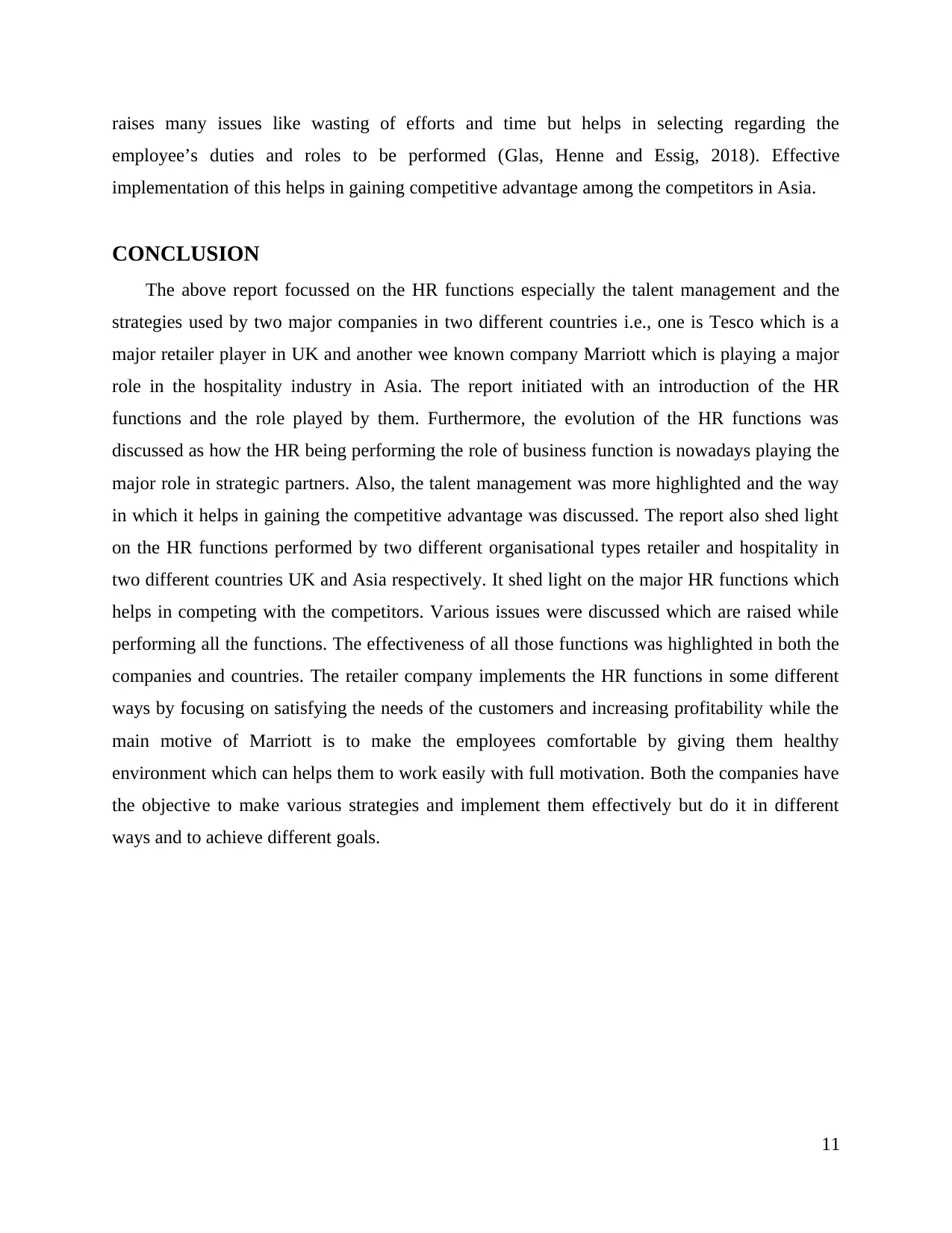
raises many issues like wasting of efforts and time but helps in selecting regarding the
employee’s duties and roles to be performed (Glas, Henne and Essig, 2018). Effective
implementation of this helps in gaining competitive advantage among the competitors in Asia.
CONCLUSION
The above report focussed on the HR functions especially the talent management and the
strategies used by two major companies in two different countries i.e., one is Tesco which is a
major retailer player in UK and another wee known company Marriott which is playing a major
role in the hospitality industry in Asia. The report initiated with an introduction of the HR
functions and the role played by them. Furthermore, the evolution of the HR functions was
discussed as how the HR being performing the role of business function is nowadays playing the
major role in strategic partners. Also, the talent management was more highlighted and the way
in which it helps in gaining the competitive advantage was discussed. The report also shed light
on the HR functions performed by two different organisational types retailer and hospitality in
two different countries UK and Asia respectively. It shed light on the major HR functions which
helps in competing with the competitors. Various issues were discussed which are raised while
performing all the functions. The effectiveness of all those functions was highlighted in both the
companies and countries. The retailer company implements the HR functions in some different
ways by focusing on satisfying the needs of the customers and increasing profitability while the
main motive of Marriott is to make the employees comfortable by giving them healthy
environment which can helps them to work easily with full motivation. Both the companies have
the objective to make various strategies and implement them effectively but do it in different
ways and to achieve different goals.
11
employee’s duties and roles to be performed (Glas, Henne and Essig, 2018). Effective
implementation of this helps in gaining competitive advantage among the competitors in Asia.
CONCLUSION
The above report focussed on the HR functions especially the talent management and the
strategies used by two major companies in two different countries i.e., one is Tesco which is a
major retailer player in UK and another wee known company Marriott which is playing a major
role in the hospitality industry in Asia. The report initiated with an introduction of the HR
functions and the role played by them. Furthermore, the evolution of the HR functions was
discussed as how the HR being performing the role of business function is nowadays playing the
major role in strategic partners. Also, the talent management was more highlighted and the way
in which it helps in gaining the competitive advantage was discussed. The report also shed light
on the HR functions performed by two different organisational types retailer and hospitality in
two different countries UK and Asia respectively. It shed light on the major HR functions which
helps in competing with the competitors. Various issues were discussed which are raised while
performing all the functions. The effectiveness of all those functions was highlighted in both the
companies and countries. The retailer company implements the HR functions in some different
ways by focusing on satisfying the needs of the customers and increasing profitability while the
main motive of Marriott is to make the employees comfortable by giving them healthy
environment which can helps them to work easily with full motivation. Both the companies have
the objective to make various strategies and implement them effectively but do it in different
ways and to achieve different goals.
11
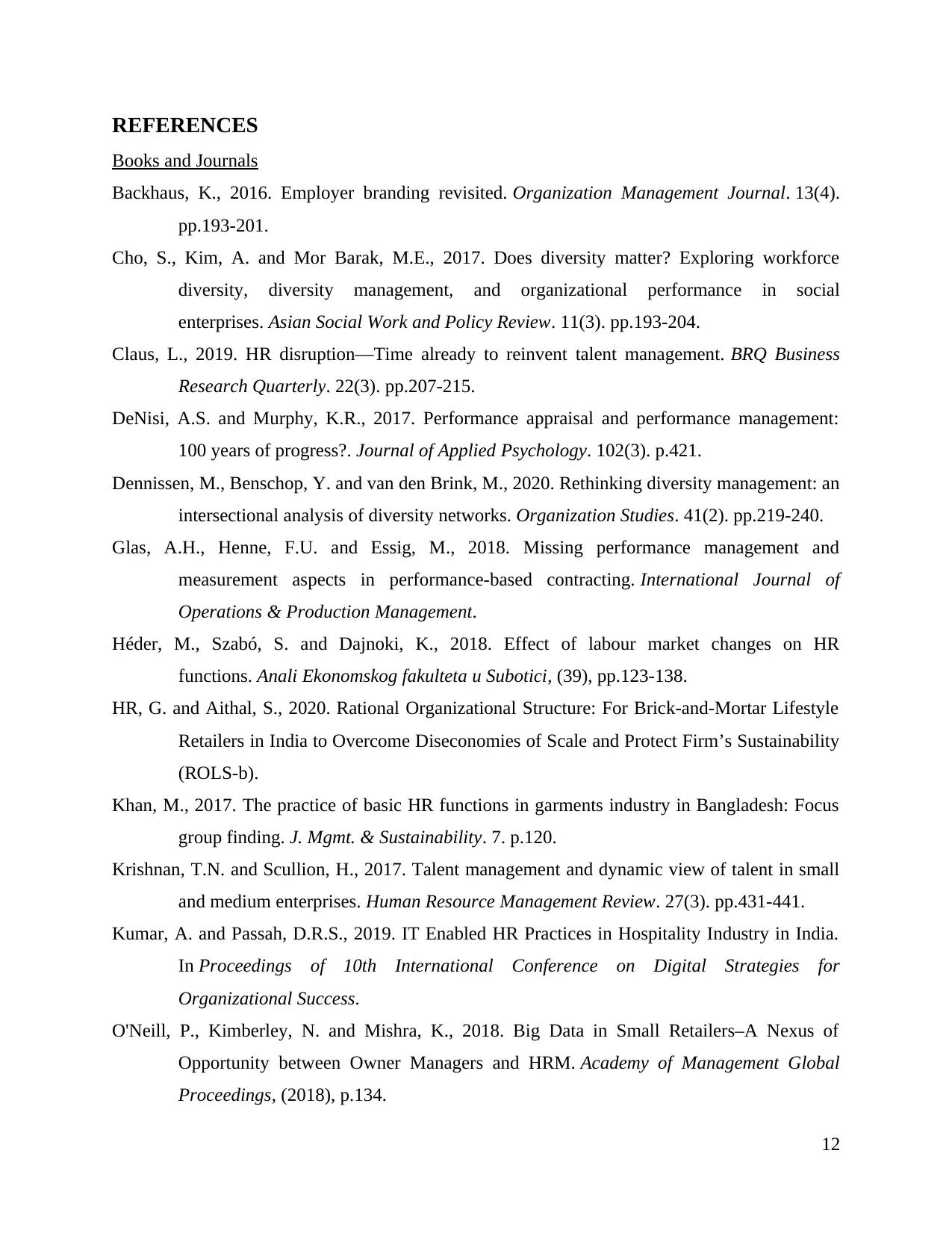
REFERENCES
Books and Journals
Backhaus, K., 2016. Employer branding revisited. Organization Management Journal. 13(4).
pp.193-201.
Cho, S., Kim, A. and Mor Barak, M.E., 2017. Does diversity matter? Exploring workforce
diversity, diversity management, and organizational performance in social
enterprises. Asian Social Work and Policy Review. 11(3). pp.193-204.
Claus, L., 2019. HR disruption—Time already to reinvent talent management. BRQ Business
Research Quarterly. 22(3). pp.207-215.
DeNisi, A.S. and Murphy, K.R., 2017. Performance appraisal and performance management:
100 years of progress?. Journal of Applied Psychology. 102(3). p.421.
Dennissen, M., Benschop, Y. and van den Brink, M., 2020. Rethinking diversity management: an
intersectional analysis of diversity networks. Organization Studies. 41(2). pp.219-240.
Glas, A.H., Henne, F.U. and Essig, M., 2018. Missing performance management and
measurement aspects in performance-based contracting. International Journal of
Operations & Production Management.
Héder, M., Szabó, S. and Dajnoki, K., 2018. Effect of labour market changes on HR
functions. Anali Ekonomskog fakulteta u Subotici, (39), pp.123-138.
HR, G. and Aithal, S., 2020. Rational Organizational Structure: For Brick-and-Mortar Lifestyle
Retailers in India to Overcome Diseconomies of Scale and Protect Firm’s Sustainability
(ROLS-b).
Khan, M., 2017. The practice of basic HR functions in garments industry in Bangladesh: Focus
group finding. J. Mgmt. & Sustainability. 7. p.120.
Krishnan, T.N. and Scullion, H., 2017. Talent management and dynamic view of talent in small
and medium enterprises. Human Resource Management Review. 27(3). pp.431-441.
Kumar, A. and Passah, D.R.S., 2019. IT Enabled HR Practices in Hospitality Industry in India.
In Proceedings of 10th International Conference on Digital Strategies for
Organizational Success.
O'Neill, P., Kimberley, N. and Mishra, K., 2018. Big Data in Small Retailers–A Nexus of
Opportunity between Owner Managers and HRM. Academy of Management Global
Proceedings, (2018), p.134.
12
Books and Journals
Backhaus, K., 2016. Employer branding revisited. Organization Management Journal. 13(4).
pp.193-201.
Cho, S., Kim, A. and Mor Barak, M.E., 2017. Does diversity matter? Exploring workforce
diversity, diversity management, and organizational performance in social
enterprises. Asian Social Work and Policy Review. 11(3). pp.193-204.
Claus, L., 2019. HR disruption—Time already to reinvent talent management. BRQ Business
Research Quarterly. 22(3). pp.207-215.
DeNisi, A.S. and Murphy, K.R., 2017. Performance appraisal and performance management:
100 years of progress?. Journal of Applied Psychology. 102(3). p.421.
Dennissen, M., Benschop, Y. and van den Brink, M., 2020. Rethinking diversity management: an
intersectional analysis of diversity networks. Organization Studies. 41(2). pp.219-240.
Glas, A.H., Henne, F.U. and Essig, M., 2018. Missing performance management and
measurement aspects in performance-based contracting. International Journal of
Operations & Production Management.
Héder, M., Szabó, S. and Dajnoki, K., 2018. Effect of labour market changes on HR
functions. Anali Ekonomskog fakulteta u Subotici, (39), pp.123-138.
HR, G. and Aithal, S., 2020. Rational Organizational Structure: For Brick-and-Mortar Lifestyle
Retailers in India to Overcome Diseconomies of Scale and Protect Firm’s Sustainability
(ROLS-b).
Khan, M., 2017. The practice of basic HR functions in garments industry in Bangladesh: Focus
group finding. J. Mgmt. & Sustainability. 7. p.120.
Krishnan, T.N. and Scullion, H., 2017. Talent management and dynamic view of talent in small
and medium enterprises. Human Resource Management Review. 27(3). pp.431-441.
Kumar, A. and Passah, D.R.S., 2019. IT Enabled HR Practices in Hospitality Industry in India.
In Proceedings of 10th International Conference on Digital Strategies for
Organizational Success.
O'Neill, P., Kimberley, N. and Mishra, K., 2018. Big Data in Small Retailers–A Nexus of
Opportunity between Owner Managers and HRM. Academy of Management Global
Proceedings, (2018), p.134.
12
⊘ This is a preview!⊘
Do you want full access?
Subscribe today to unlock all pages.

Trusted by 1+ million students worldwide
1 out of 14
Related Documents
Your All-in-One AI-Powered Toolkit for Academic Success.
+13062052269
info@desklib.com
Available 24*7 on WhatsApp / Email
![[object Object]](/_next/static/media/star-bottom.7253800d.svg)
Unlock your academic potential
Copyright © 2020–2025 A2Z Services. All Rights Reserved. Developed and managed by ZUCOL.





